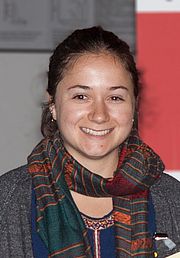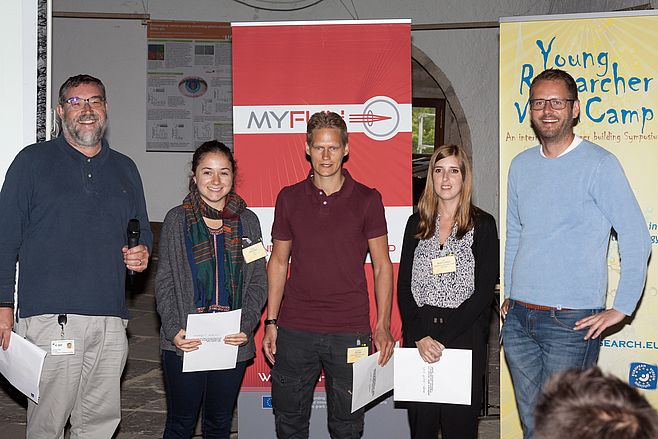You are here: vision-research.eu » Vision Research » Vision in the European Focus » 2017 » ZEISS Scientific Poster Award at the Young Researcher Vision Camp 2017
ZEISS Scientific Poster Awards
at the Young Researcher Vision Camp 2017

This year's three award winners are:
- Ana Ruiz-Lopez from Cork in Ireland
- Paulus Saari from Oulu in Finland
- Erika Aquino from London, United Kingdom
ZEISS recognizes the winners for outstanding scientific contributions and awards excellence in research in vision and ophthalmology.
This year it was a difficult task for the award committee to select the three most attractive contributions from a selection of high quality posters.
The sponsor ZEISS was represented by Dr. Arne Ohlendorf, who presented the greeting by Dr. Timo Mappes, Senior Vice President Innovation and Dr. Christian Lappe, Director Technical Communications & Scientific Affaires. Thereby ZEISS recognizes outstanding scientific contributions and awards excellence in research and congratulate to the winners of the ZEISS Poster Award @ the Young Researcher Vision Camp 2017.
The CEO of the European Vision Institute Dr. Thomas Wheeler-Schilling, stressed the high quality of this year's poster presenters.
"All young researchers are winners by attending the Vision Camp."
He thanked the highly motivated poster award committee and their intense and dedicated discussion to find the three diamonds under all the true precious stones: "Our congratulations go to all poster presenters".

1st ZEISS Awardee – Ana Ruiz Lopez
At the end the first prize was awarded to Ana Ruiz Lopez and Thomas G. Cotter from the Cell Development and Disease Laboratory, Biosciences Institute, University College Cork, Ireland.
The title of their presentation was "Pro-survival redox signalling in progesterone-mediated retinal neuroprotection". Their conclusion was that their study presents an essential role for ROS signalling in Norgestrel-mediated neuroprotection in vitro and demonstrates that Norgestrel employs a similar pro-survival mechanism in the degenerating retina.

2nd ZEISS Awardee - Paulus Saari
The second prize was entiteled "Co-expression of multiple opsins underlies broad spectral sensitivity of cockroach photoreceptors" by Paulus Saari, Esa-Ville Immonen, Andrew French, Hongxia Liu, Paivi Torkkeli, and Roman Frolov¹ from the Faculty of Science, Department of Physics, Division of Biophysics, University of Oulu, Finland and the Department of Physiology and Biophysics, Dalhousie University, Halifax in Canada.

3rd ZEISS Awardee– Erika Aquino
The third prize went to Erika Aquino, Karen Eastlake, Peng Khaw and Astrid Limb at the UCL Institute of Ophthalmology, London and the National Institute for Health research (NIHR) Biomedical Research Centre at Moorfields Eye Hospital NHS Foundastion Trust in London, United Kingdom.
The topic covered "Encouraging retinal repair by preventing gliosis mediated by Müller glia".
The Abstracts
Pro-survival redox signalling in progesterone-mediated retinal neuroprotection
Ana Ruiz Lopez Thomas G. Cotter
Cell Development and Disease Laboratory, Biosciences Institute, University College Cork, Ireland
Purpose
Retinitis pigmentosa (RP) is a group of hereditary retinal diseases, characterised by photoreceptor cell loss. Despite a substantial understanding of the mechanisms leading to cell death, an effective therapeutic strategy is sought. Our laboratory has previously demonstrated the neuroprotective properties of Norgestrel, a progesterone analogue, in the degenerating retina, mediated in part by the neurotrophic factor basic fibroblast growth factor (bFGF). In other retinal studies, we have also presented a pro-survival role for reactive oxygen species (ROS), downstream of bFGF. The aim of the current study was to study the role of ROS production in survival responses following Norgestrel treatment.
Methods
The 661W photoreceptor cell line and the rd10 mouse model of RP were used in the experiments performed. Serum deprivation was used to induce stress for the time indicated. Flow cytometry was used to measure ROS levels, while bFGF levels were measured by rtPCR and western blotting. Cell viability and proliferation were analyzed using MTS assay in cells and TUNEL staining in retinal explants.
Results
Norgestrel enhances an early pro-survival burst of ROS up to 1h in the stressed cells. No changes in ROS are seen in the absence of bFGF action through either blocking its receptor (PGRMC1) or using siRNA, suggesting this burst is mediated by the up-regulation of bFGF at 30 min following serum starvation (SS). Norgestrel-driven protection was attenuated in the presence of antioxidants. This may in part explain its protective effects on the 661W cells. Using the rd10 mouse model of RP, we confirm that Norgestrel induces a similar early pro-survival increase in retinal ROS.
Conclusions
This study therefore presents an essential role for ROS signalling in Norgestrel-mediated neuroprotection in vitro and demonstrates that Norgestrel employs a similar pro-survival mechanism in the degenerating retina.
Statement on proprietary interests
The authors have no conflict of interest to declare.
Acknowledgement
This work was supported by Science Foundation Ireland (SFI) (grant no. 13/IA/1783), and Fighting Blindness Ireland (registered charity number 20013349).
Co-expression of multiple opsins underlies broad spectral sensitivity of cockroach photoreceptors
Paulus Saari1*, Esa-Ville Immonen¹, Andrew French², Hongxia Liu², Paivi Torkkeli², and Roman Frolov¹
1 Faculty of Science, Department of Physics, Division of Biophysics, University of Oulu, P.O. Box 3000, FI-90014 University of Oulu, Finland 2Department of Physiology and Biophysics, Dalhousie University, P.O. BOX 15000, Halifax, NS, B3H 4R2, Canada *corresponding author
Abstract
We have recently created the retinal transcriptome of Periplaneta americana and successfully used gene-specific in vivo RNA interference (RNAi) to suppress expression of several proteins involved in phototransduction. Here, by using intracellular and patch-clamp recording methods we provide functional analysis of transcriptional silencing of green opsins achieved by injecting long (596 bp) double-stranded RNA into head hemolymph. Recordings were performed during 10–22 days post-injection. We measured basic electrical properties, spectral and absolute sensitivities to light, elementary current and voltage responses (bumps), macroscopic light responses and voltage-activated K+ currents. In 8 out of 9 treated animals, absolute sensitivity of green-sensitive photoreceptors decreased by 2 to 5 orders of magnitude in comparison to controls. No effect was observed on current quantum bumps or anything else except spectral sensitivity, indicating that disruption of opsin synthesis did not affect phototransduction and membrane properties. Almost all photoreceptors in control showed broad spectral sensitivity with maximal responses to green and substantial responses to UV light. However, opsin RNAi cockroaches demonstrated exclusive sensitivity to UV light albeit not exceeding that in control. These results imply that some of cockroach photoreceptors express at least two opsins, green and UV. Considering that the transfer of UV-specific information over a mixed channel is not possible, and that cockroaches are mainly active at dusk and dawn, when the fraction of UV in ambient light is maximized, this co-expression has likely evolved to fully utilize the available spectral range and through this optimize motion detection and recognition of conspecifics.
Encouraging retinal repair by preventing gliosis mediated by Müller glia
n/a



